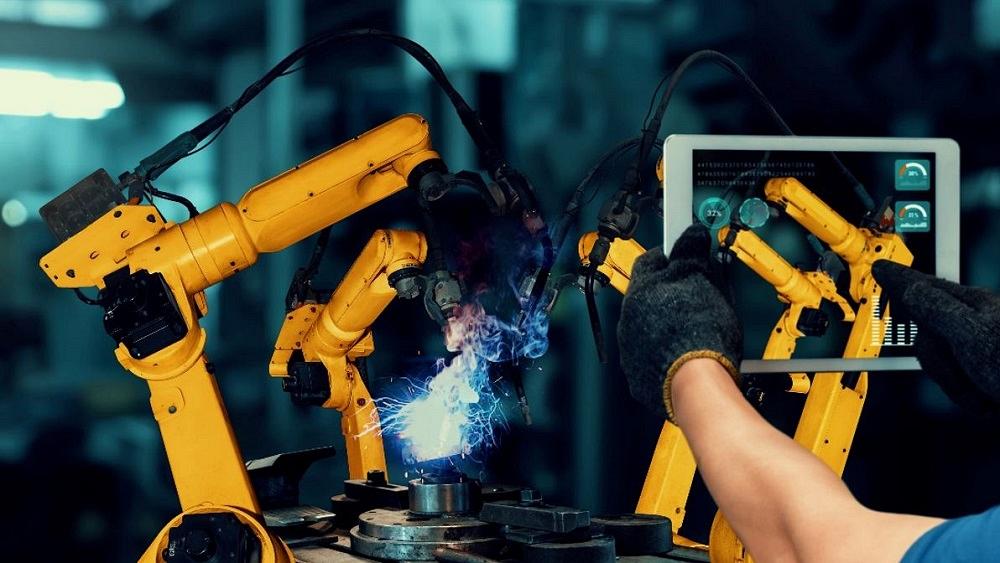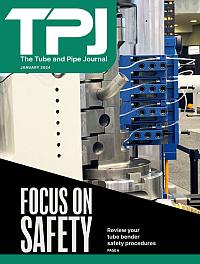Editor
- FMA
- The Fabricator
- FABTECH
- Canadian Metalworking
Categories
- Additive Manufacturing
- Aluminum Welding
- Arc Welding
- Assembly and Joining
- Automation and Robotics
- Bending and Forming
- Consumables
- Cutting and Weld Prep
- Electric Vehicles
- En Español
- Finishing
- Hydroforming
- Laser Cutting
- Laser Welding
- Machining
- Manufacturing Software
- Materials Handling
- Metals/Materials
- Oxyfuel Cutting
- Plasma Cutting
- Power Tools
- Punching and Other Holemaking
- Roll Forming
- Safety
- Sawing
- Shearing
- Shop Management
- Testing and Measuring
- Tube and Pipe Fabrication
- Tube and Pipe Production
- Waterjet Cutting
Industry Directory
Webcasts
Podcasts
FAB 40
Advertise
Subscribe
Account Login
Search
Making the most of the robotic revolution in fabrication
Cobots can bridge multiple gaps for shops hurting for people
- By Lincoln Brunner
- January 18, 2024
- Article
- Tube and Pipe Fabrication

Cobot systems such as the ones offered by Melton Machine & Tool can take rote production tasks off the plates of human welders, who can focus on more interesting and complex tasks instead.
In the movies, interaction with robots typically takes a dark turn: A scientist creates a robot to make her life easier. But something goes terribly wrong when the robot takes over and terrorizes her and everyone in Los Angeles.
Or something like that.
In manufacturing, the thought of robots, specifically cobots, may instill fear of that piece of machinery replacing human labor.
However, for tube and pipe fabricators, the reaction should be that robots are not only making life easier for the human beings that use them but also improving the work those people are doing while not stealing jobs from them.
Take welders, for example. They are precisely the people who may look askance at equipment like Melton Machine & Control’s CoboWeld cooperative robot welding machine.
Melton, a builder of automated welding systems in Washington, Mo., integrates machines from a variety of go-to vendors—mainly Universal Robots for its robotic components, along with welding machines from Fronius, Miller Electric, OTC Daihen, SKS Welding Systems, and Lincoln Electric. The CoboWeld features GMAW (MIG) units—representing about 80% of units sold—or two different GTAW (TIG) systems.
“Most of the time, in a MIG application, you’re doing it because you need to go relatively fast,” said Glenn Archer, Melton’s vice president of sales and marketing. “But we have some customers that want to do fusion welding with a TIG system. However, some customers that do that, when they get into it, they say, ‘In order to do this, I’m going to have to have some makeup material.’ So we also have a cold wire feed TIG system.”
Transforming the Operation
About half of the systems Melton sold last year featured cobots. What Melton has noticed among its customers is not a usurpation of those welders’ jobs, but a transformation. In so doing, companies are identifying the jobs that machines and people are better at, respectively, and making the most of both simultaneously.
“It’s not the easiest thing in the world to put a 37-degree angle out there and then when you get to a corner change it to 42 degrees,” Archer said. “People are good, but the robot’s better at doing that sort of thing repeatedly. What the robot’s not great at is, if while you’re welding along, you see some kind of condition and you’ve got to choose one of three ways you’re going to go from there. The robot’s not going to make a lot of choices like that well—at least not right now.
“What we find is that customers that will buy a system like this are concerned that the welders there are going to get mad at them,” he said. “What ends up happening is, the welders at the plant end up still getting to do manual welding, but they’re getting to do more interesting stuff—maybe it’s repairs, maybe it is new prototypes. But the day to day—take this 47 in. of weld and lay it down eight hours a day—most of them aren’t really excited to go in and do that. So, the cobots are really good at doing that repetitive stuff.”

Many cobot systems have become easy enough to learn that even neophytes can begin welding with them in as little as 15 or 20 minutes.
Filling the Other Gap
Another thing that cobots still aren’t universally good at doing is compensating for differing gaps in raw material. One gap may require four beads to fill it, another one or two. Through-arc seam tracking, laser sensors, and visual monitoring systems are rapidly improving to help robotic systems identify and compensate for varying gaps in real time.
In addition, lasers and cameras often must be set far enough in front of the weld arc (often about 18 in.) to ensure that arc radiation doesn’t interfere with the laser or camera. That’s fine for long parts, but for parts smaller than that lead length, not so much.
“I think as [technology] improves, it will make it even easier to do smaller parts,” Archer said.
However, a ¼-in. space between parts isn’t the only gap that the CoboWeld is designed to fill. It’s the ever-present lack of welders felt by fabrication shops worldwide. The consensus estimated shortage, just in North America, is 450,000 to 500,000 welders.
“Probably 98% of the people we talk to can’t find people who want to weld,” Archer said. “We live in a society where everyone wants to get ahead. They want to make money, but not as many people want to take on something that may have the connotation of a dirty job.”
Meeting the resulting need meant designing the technology behind the CoboWeld to be user-friendly for people with little or no welding experience.
After buying a CoboWeld recently, one metalworking shop sent its accountant to Melton to test-drive it to see if it was truly going to be worth the money.
“We put the pendant in the accountant’s hand and said, ‘Here, you’re going to weld this,’” Archer recalled. “He said, ‘I can’t weld! I’ve never welded in my life.’ And in 15 or 20 minutes, he welded his first piece.
“And then he said, ‘If I can do it, everybody in my plant can do it—we need more of these.’ And I think they’ve got three of them running in their facility right now.”
The quicker that manufacturers dispel the fears and myths associated with cobot system adoption, the faster they’ll be able to find innovative uses for those pieces of machinery and assign complex jobs to their human staff.
Leave the robot horror stories to Hollywood.
About the Author

Lincoln Brunner
2135 Point Blvd.
Elgin, IL 60123
(815)-227-8243
Lincoln Brunner is editor of The Tube & Pipe Journal. This is his second stint at TPJ, where he served as an editor for two years before helping launch thefabricator.com as FMA's first web content manager. After that very rewarding experience, he worked for 17 years as an international journalist and communications director in the nonprofit sector. He is a published author and has written extensively about all facets of the metal fabrication industry.
About the Publication
subscribe now

The Tube and Pipe Journal became the first magazine dedicated to serving the metal tube and pipe industry in 1990. Today, it remains the only North American publication devoted to this industry, and it has become the most trusted source of information for tube and pipe professionals.
start your free subscription- Stay connected from anywhere

Easily access valuable industry resources now with full access to the digital edition of The Fabricator.

Easily access valuable industry resources now with full access to the digital edition of The Welder.

Easily access valuable industry resources now with full access to the digital edition of The Tube and Pipe Journal.
- Podcasting
- Podcast:
- The Fabricator Podcast
- Published:
- 04/16/2024
- Running Time:
- 63:29
In this episode of The Fabricator Podcast, Caleb Chamberlain, co-founder and CEO of OSH Cut, discusses his company’s...
- Trending Articles
Zekelman Industries to invest $120 million in Arkansas expansion

3D laser tube cutting system available in 3, 4, or 5 kW

Corrosion-inhibiting coating can be peeled off after use

Brushless copper tubing cutter adjusts to ODs up to 2-1/8 in.

HGG Profiling Equipment names area sales manager

- Industry Events
16th Annual Safety Conference
- April 30 - May 1, 2024
- Elgin,
Pipe and Tube Conference
- May 21 - 22, 2024
- Omaha, NE
World-Class Roll Forming Workshop
- June 5 - 6, 2024
- Louisville, KY
Advanced Laser Application Workshop
- June 25 - 27, 2024
- Novi, MI


























